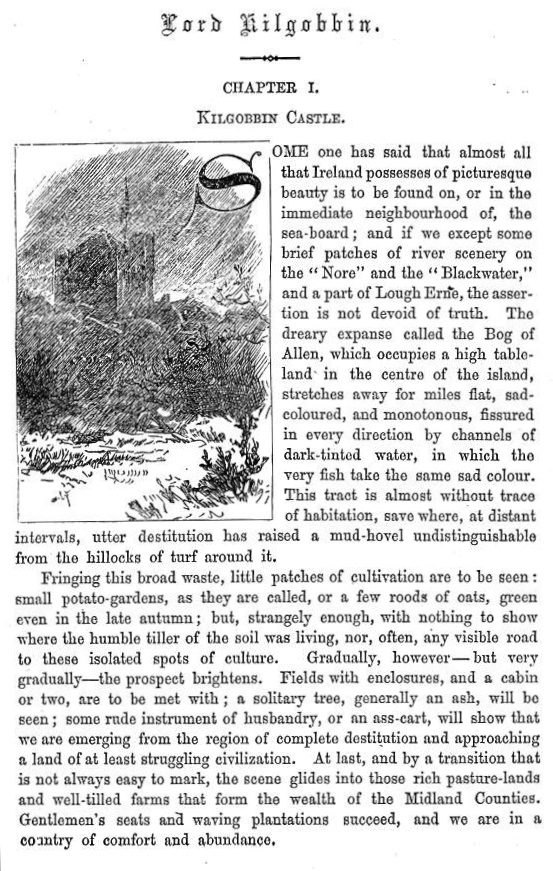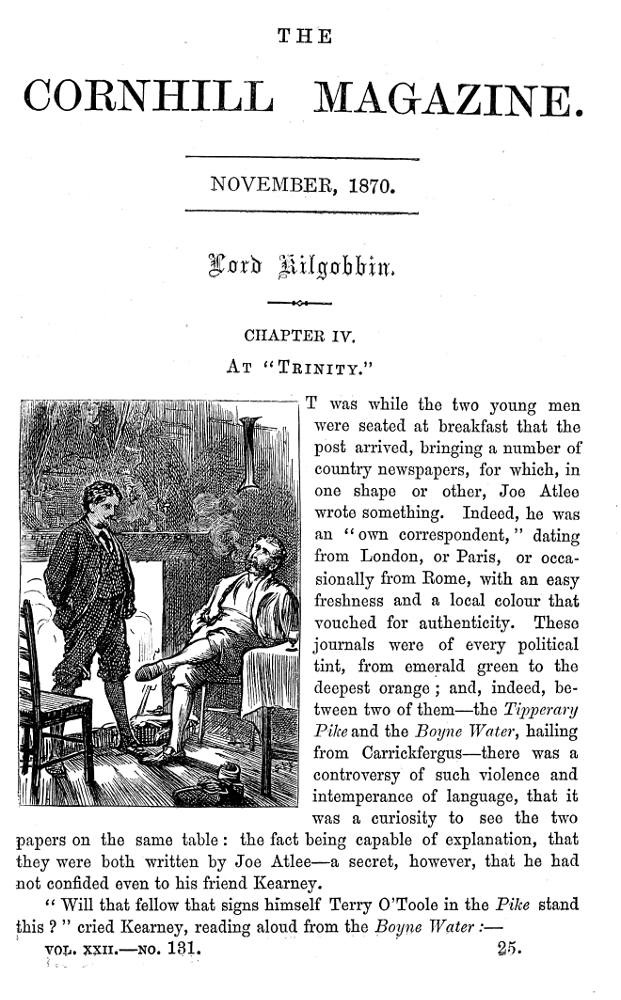
"What lark have you been on, Master Joe?" by Sir Luke Fildes. Second illustration for Charles Lever’s Lord Kilgobbin: A Tale of Ireland in Our Time, facing p. 17. Reprinted from the October 1870 number of the Cornhill Magazine, Vol. XXII, facing p. 493. 10.6 cm by 15.9 cm (4 ⅛ by 6 ¼ inches), framed. Initial serial illustration, Part 1, Chapter III, "The Chums." [Click on the illustration to enlarge it.]
Passage Illustrated: Dick Kearney and Joe Atlee in their rooms at Trinity College, Dublin

Right: The initial page for the first instalment in Volume XXII of the Cornhill Magazine (October, 1870), Chapter I, p. 493.
In that old square of Trinity College, Dublin, one side of which fronts the Park, and in chambers on the ground-floor, an oak door bore the names of "Kearney and Atlee."
Kearney was the son of Lord Kilgobbin; Atlee, his chum, the son of a Presbyterian minister in the north of Ireland, had been four years in the university, but was still in his freshman period, not from any deficiency of scholarlike ability to push on, but that, as the poet of the Seasons lay in bed, because he "had no motive for rising," Joe Atlee felt that there need be no urgency about taking a degree which, when he had got, he should be sorely puzzled to know what to do with. He was a clever, ready-witted, but capricious fellow, fond of pleasure, and self-indulgent to a degree that ill suited his very smallest of fortunes, for his father was a poor man, with a large family, and had already embarrassed himself heavily by the cost of sending his eldest son to the university. Joe’s changes of purpose — for he had in succession abandoned law for medicine, medicine for theology, and theology for civil engineering, and, finally, gave them all up — had so outraged his father that he declared he would not continue any allowance to him beyond the present year; to which Joe replied by the same post, sending back the twenty pounds inclosed him, and saying: "The only amendment I would make to your motion is — as to the date — let it begin from to-day. I suppose I shall have to swim without corks some time. I may as well try now as later on."
The first experience of his "swimming without corks" was to lie in bed two days and smoke; the next was to rise at daybreak and set out on a long walk into the country, from which he returned late at night, wearied and exhausted, having eaten but once during the day.
Kearney, dressed for an evening party, resplendent with jewellery, essenced and curled, was about to issue forth when Atlee, dusty and wayworn, entered and threw himself into a chair.
"What lark have you been on, Master Joe?" he said. "I have not seen you for three days, if not four!" [Chapter III, "The Chums," pp. 16-17]
Commentary: The "Chums" are a Study in Contrasts

Left: The initial page for the second instalment in Volume XXII of the Cornhill Magazine (November, 1870), Chapter IV, p. 513.
Fildes underscores the intergenerational conflict among the Kearneys of Kilgobbin by depicting the melancholy Richard (Dick) Kearney, an undergraduate at Trinity College, Dublin, in contrast to the decaying ancestral Norman keep in the initial-letter vignette. This full-page wood-engraving and the second vignette both depict the headstrong Dick, Matt Kearney's son, and his cheerful but financially constrained Protestant roommate, Joe Atlee. This markedly urban and modern scene contrasts the traditional world of the Irish rural estate from the opening chapter. Fildes provokes the reader to examine why, despite his wealth, education, and social status, Dick is depressed as he contemplates going to Letty Clancy's birthday party. His fashionable clothing marks him as a member of Dublin society: "Kearney, dressed for an evening party, resplendent with jewellery, essenced and curled" (17) contrasts Joe Atlee, still dressed for the street, and just returned from some three-day ramble in which he has eaten nothing. This scene culminates the action of the first serial instalment, which has introduced all the present-day Kearneys, including Dick's sister, Kitty, and their continental cousin, Nina Kostalergi, and her back-story Curiously, Fildes shows Joe smoking a cigar, whereas Lever specifies that he is a three-pipe-a-day man, his favourite tobacco being Cavendish. In his catalogue of his personal belongings, Joe describes himself son of the Reverend Isaac Atlee of Coleraine in Northern Ireland, and the old friend of a thief "transported for Fenianism" (21).
Scanned images captions, and commentary by Philip V. Allingham. [You may use these images without prior permission for any scholarly or educational purpose, as long as you (1) credit the person who scanned them, and (2) link your document to this URL in a web document or cite the Victorian Web in a print one.]
Bibliography
Lever, Charles. Lord Kilgobbin. The Cornhill Magazine. With 18 full-page illustrations and 18 initial-letter vignettes by S. Luke Fildes. Volumes XXII-XXV. October 1870-March 1872.
Lever, Charles. Lord Kilgobbin: A Tale of Ireland in Our Own Time. With 18 Illustrations by Sir Luke Fildes, R. A. London: Smith, Elder, 1872, 3 vols; rpt., Chapman and Hall, 1873.
Lever, Charles. Lord Kilgobbin. Illustrated by Sir Luke Fildes. Novels and Romances of Charles Lever. Vols. I-III. In three volumes. London: Smith, Elder, 1872, Rpt. London: Chapman & Hall, 1873. Project Gutenberg. Last Updated: 19 August 2010.
Stevenson, Lionel. Chapter XVI, "Exile on the Adriatic, 1867-1872." Dr. Quicksilver: The Life of Charles Lever. New York: Russell and Russell, 1939; rpt. 1969. Pp. 277-296.
Sutherland, John A. "Lord Kilgobbin." The Stanford Companion to Victorian Fiction. Stanford, Cal.: Stanford U. P., 1989, rpt. 1990, 382.
Created 7 July 2005 Updated 16 June 2023